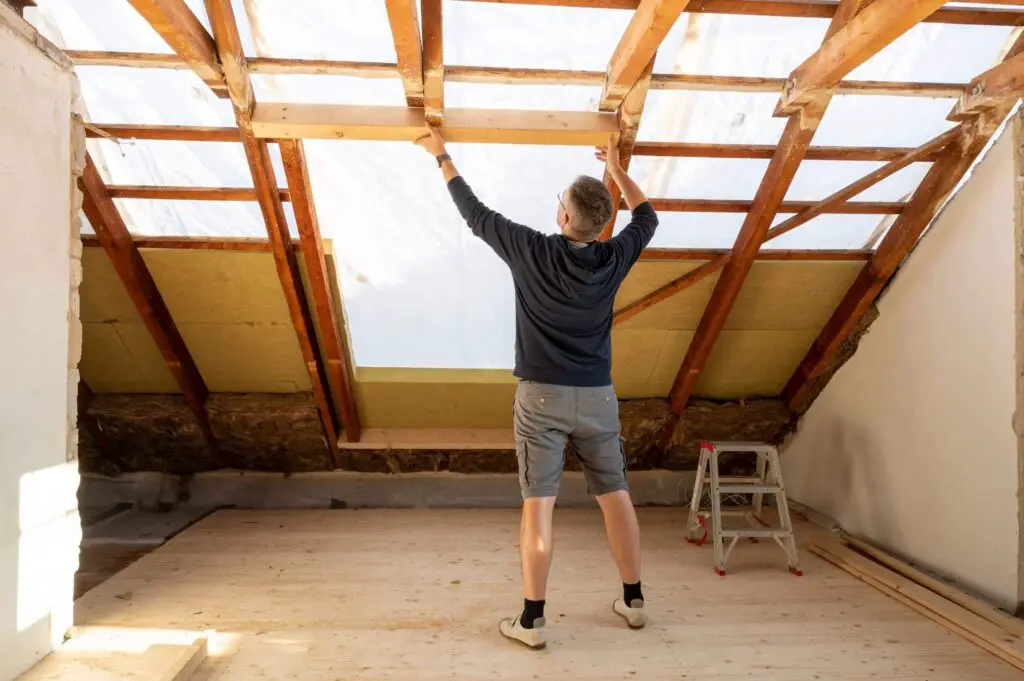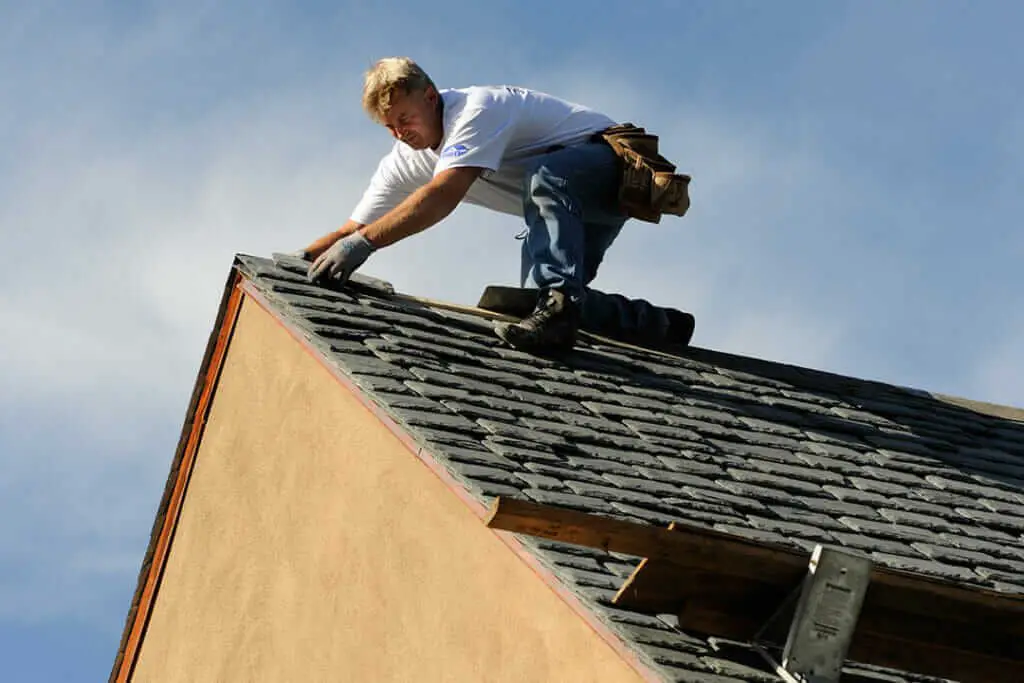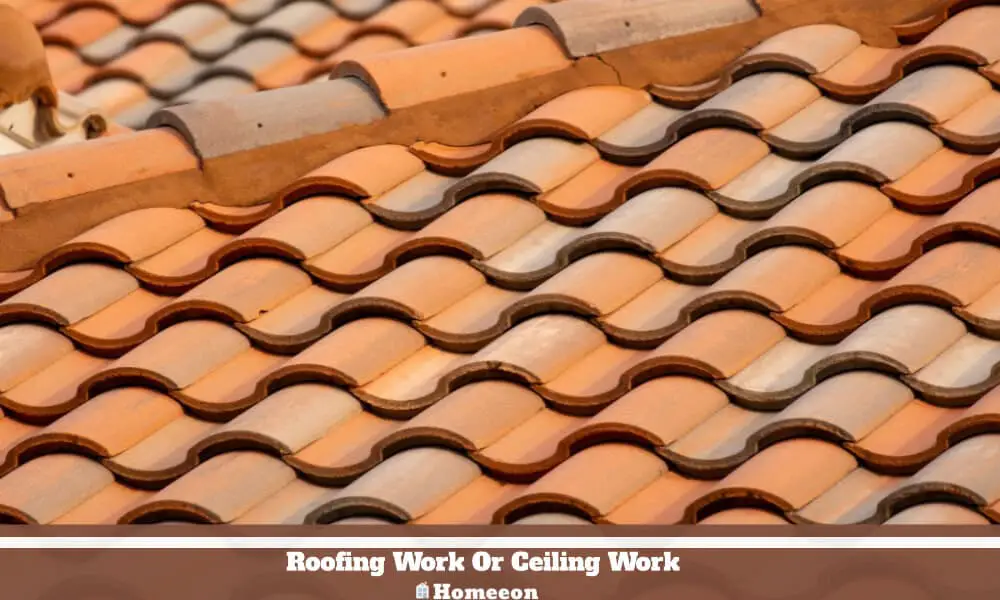Last Updated on July 31, 2023 By Emma W. Thomas
Roofing work is typically done before ceiling work. Once the roof is constructed or repaired, it provides protection from the elements. Afterward, ceiling work, including installation or repairs, is undertaken inside the structure to finish the interior.
Why Is Roofing Work Done First Before Ceiling Work?

Roofing work is part of the external structures of a building. Most building codes require you to finish laying the outer features before carrying out the interior finishing. Mostly, internal finishings are susceptible to environmental factors such as rainfall or heat from the sun and are likely to get damaged. For example, the paint used on the inside cannot survive the outside weather conditions as it will peel out and fade. The same case applies to the ceilings.
Some materials used for the ceiling cannot withstand external weather conditions, such as cardboard and plaster. They would break into pieces, especially if they come into contact with water and then heat from the sun. For this reason, roofing is done first to offer protection to such fragile internal parts of a building.
What Is The Difference Between A Roof And A Ceiling?
Some people tend to use the terms roof and ceiling interchangeably, thinking they refer to the same thing. The two are as different as a nut and bolt, making it easy to distinguish them.
A roof is the topmost outer part of a building that protects the inside of the structure from weather elements. All structures used as dwellings need roof protection. Some places have incredibly harsh weather conditions, and roofs must be designed to provide insulation. There are different types of roofs depending on their uses or requirements and the purpose of the structure to be roofed.
There are also some abiding rules and regulations that must be adhered to when roofing which sometimes differ from state to state. A wide range of materials are used for roofing ranging from humble banana leaves to concrete, ceramic, tiles, steel, and other metallic types used today as roofing options.
On the other hand, the ceiling is the uppermost interior structure in a building. A ceiling is not part of the roofing but just an artificial construction made to enhance the look and feel of a room. Most ceilings are not as durable as the roof, which in most cases can last even for decades. Ceilings are part of a building, and individuals try to make them as attractive and exciting as possible to create a nice ambiance in a room. Many ceiling decorative styles depend on the building size and also the budget.
The most distinguishing feature between the roof and the ceiling is that the roof is external, whereas the ceiling is internal. During construction, the roof is installed first before the ceiling, and other finishing to a building, such as paint, is done. Roofs also protect the inside of a building from harsh weather conditions, whereas the ceiling is mostly about aesthetics. A roof must also be durable for maximum protection of the inmates, whereas a ceiling must maintain a good and pleasing look and durability is not much of an option.
What Are The Uses Of A Roof?
A roof is an essential structure in any building used as a dwelling. It has the following uses;
Protection
A roof stands in between your house and the exterior world and environment. A good roof serves as a good protection barrier against hail storms, snow, rain, ice, and debris. Poorly installed roofs are prone to leakages, which develop into mold and mildew, especially when moisture reaches the ceiling.
Even the most minor leaks can cause a significant water problem to other home systems. For this reason, your investment in a good roof should be a big-time thing to ensure you have a perfect roofing system.
Home Value
A sound roofing system increases your home value by enhancing its curb appeal. You should maintain it properly to prevent moss and algae from covering your roof. A sagging and decrepit roof shows poor home maintenance and is unappealing. It sends signals of home negligence and an unkempt home. A house with a roof in good shape can make a potential buyer assume that the rest of the house is also in perfect condition. Sometimes it can even translate to a higher selling price.
Energy Efficiency
Even if you are not going to put up your house for sale, a good roof is still valuable. A structurally sound roof provides a home with proper ventilation and sufficient insulation in the attics hence fewer air leaks in your home. It ensures more comfort even with the air conditioner at higher temperatures as it translates to lower cooling and heating bills.
Roofing is most suitable for people who care about their comfort and want to save money while still protecting their home value using a good roof.
When Should You Replace Your Roof?
Sometimes it is not about just having a roof. It must be in good condition and serving its intended purpose. A bad roof can cause more damage, costing you more than just the replacement cost due to external factors that could pass through a spoiled roof, such as water leaks. Here are some signs that will require you to replace your roof;
Damaged And Missing Shingles
These are the first indications of a damaged roof. Shingles show their damage by starting to get curled, developing cracks, and sometimes losing their granules. When they fall in such conditions, they cannot offer the proper roofing protection to your home and need replacement to prevent further damage to the interior parts such as the ceiling. They could also serve as entry points for dangerous animals such as snakes into the house.
Light Coming Through The Attic
If you see the light coming through the attic, it indicates a roof part has fallen out. You should consider replacement as soon as you notice the damage, as the more the opening remains unfixed, the more destruction it will cause. Replacing the roof early enough is better than incurring the cost associated with damages from a small roof problem that could have been avoided had attention been paid to it earlier.
Widespread Stains
Roof stains are an indication of algae and moss presence. They both degrade shingles by trapping water which causes their damage by compromising the roof. Extensive moss and algae spread is dangerous to a roof and should be replaced to prevent further damage.
Age
Some roofs can stay for decades without showing any physical damage but fail to serve some purpose, such as losing their good look. Others leak, and at first, it might go unnoticed. Such roofs that fail to show their immediate damage are dangerous as they could collapse during a heavy storm or snow. Rather than wait for such an incident, you should consider replacing your roof when you feel that it is old enough or upon expiry of its stated lifespan.
What Are The Uses Of Ceilings?
Ceilings form one of the most critical structural elements while still serving an artistic function. They help to give a building an excellent aesthetic look in the interior. Ceilings also help in creating closure and separation between two spaces. They also provide appealing lighting by controlling the amount of light diffusing into a room. Some ceilings control sounds around a room as they are soundproof, which prevents the passage of sound in-between spaces.
Some ceilings have fire-resistant properties that enable them to facilitate building services such as vents, sprinkler heads, and lighting. Shelters also serve as concealing agents for pipes, ducts, and wiring systems used in a building. Some ceiling types, such as interstitial, leave an intermediate space between regular-use floors. Such a ceiling is mainly used in hospitals and laboratories to allow room for mechanical systems used in the building.
What Is The Difference Between A Ceiling And A False Ceiling?
A ceiling is the uppermost interior part of a building. In contrast, a false ceiling is an additional fitted ceiling that hangs below the central ceiling suspended by metal or wooden frames. They are mostly installed at least 8 inches from the original ceiling, making them appear lower. They are versatile and can be applied in any home design as it allows the constructor to play around with shapes depending on the available space.
The most commonly used materials for false ceilings are gypsum, plaster of Paris, and false wooden ceilings. Gypsum and plaster false ceilings are more expensive and usually choose most Indian homes as they are more customizable than false wooden ceilings.
Is the ceiling part of the roofing?
No, the ceiling is not part of the roofing itself, but rather a component of the interior construction. Let’s delve into the details:
- Roofing: The roofing refers to the exterior covering of a building’s uppermost part, designed to protect the structure from weather elements such as rain, snow, sunlight, and wind. It includes materials like shingles, tiles, metal sheets, or other waterproofing layers installed on the roof’s surface. The roofing’s primary purpose is to keep the building’s interior dry and safe.
- Ceiling: The ceiling, on the other hand, is an interior element of the building located underneath the roofing structure. It forms the upper surface of a room and is visible from within the building. The ceiling can be made of various materials, such as drywall, plaster, wood, or suspended ceiling tiles. Its purpose is to enclose the space, create a finished look, and provide a barrier between the interior and the attic or roof space.
In summary, while the roofing protects the building from external elements, the ceiling forms part of the interior construction and serves to enclose and enhance the aesthetic appeal of the living space. Both the roofing and the ceiling play crucial roles in the overall construction of a building, but they are distinct components serving different purposes.
What Are The Pros And Cons Of False Ceilings?

One of the advantages of false ceilings is that they provide an excellent acoustic design by adding additional layers to the original ceiling making it more appealing and perfect for living. They bring out the ideal proportion as they tend to be lower than the standard ceiling. They also tend to hide away wires better as you can fit them with recessed lighting.
However, they have two main disadvantages. First, they require a lot of precision and expertise during installations since you need many calculations. They are associated with perfect designs, and they must be professionally done to bring out the desired look. False ceilings are not feasible for low-ceilinged rooms as they need to be at least 8 inches away from the original ceilings.
Conclusion
Roofing work must be done before ceiling work begins since the roof provides overall protection to things inside a building, including the ceiling. Installing ceilings before the top could lead to damage from rain and heat. Ceilings are fragile and can easily get damaged when exposed to harsh external factors such as rain, snow, or excess heat from the sun.
References:
https://bulletproofroofsystems.com/ceiling-work-or-roofing-work/
https://www.finehomebuilding.com/forum/whats-first-floor-ceiling-or-walls
Emma is a graduate of Domestic Science or Family and Consumer Sciences (Home Economics) from the University of Wisconsin. She has 7 years of experience Working with the strategic section of BestBuy and now writing full-time for Homeeon.
From Managing the Home, Interiors, Cleaning, and Exteriors to Gardening and everything about Making A Home Liveable – is her passion and this Homeeon is the result of this.
Emma loves decorating her home with the best stuff found online. She cares about quality over anything and writes reviews about them here in Homeeon. Get in touch with her over Pinterest.
Keep reading her blogs.

